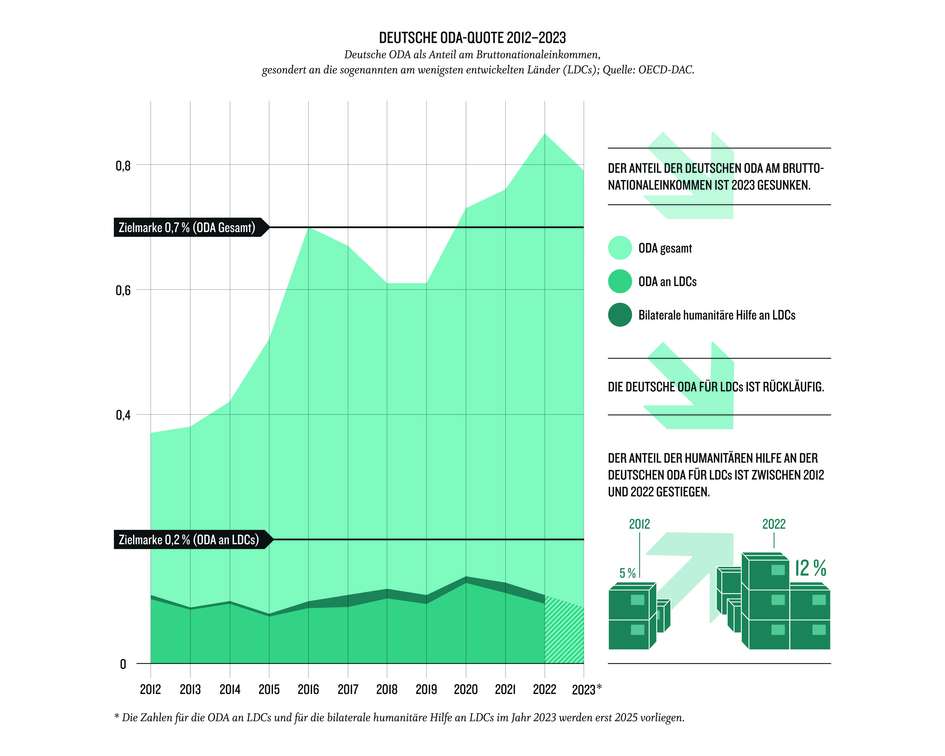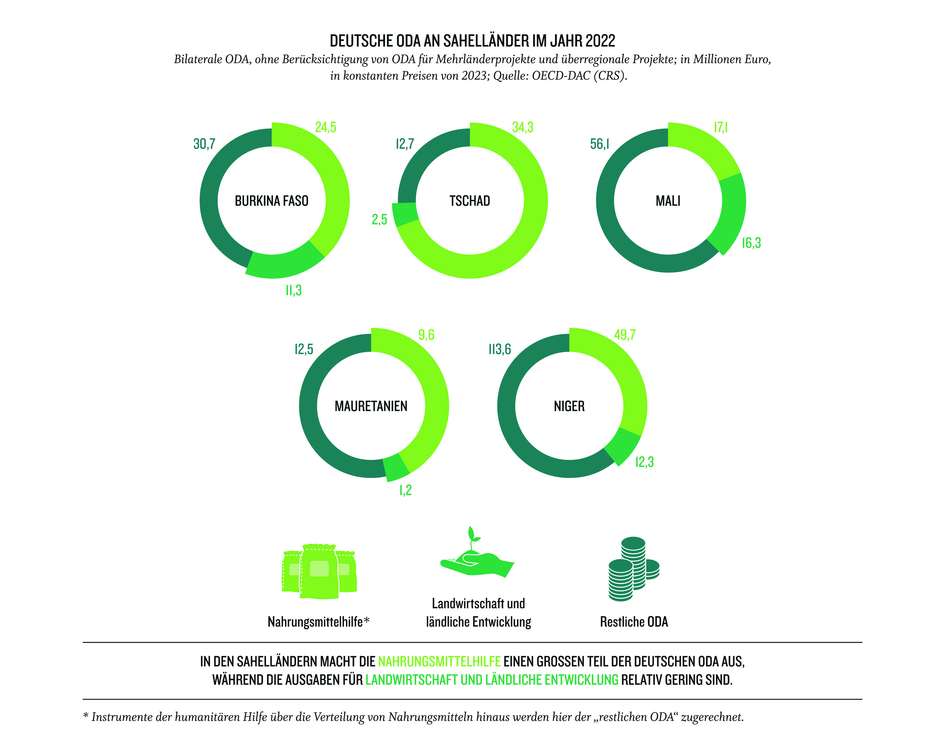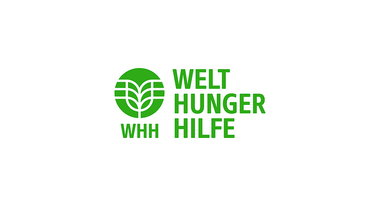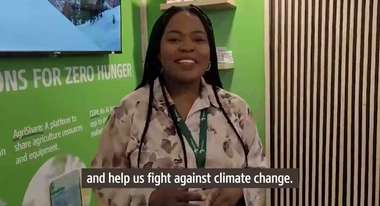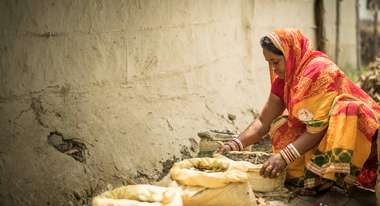Kompass 2024: German ODA Does Not Keep Up with Complex and Multiple Crises
The trends run counter to each other: While the world is facing multiple crises and increasing fragility, Germany is investing less in its international commitments and humanitarian aid.
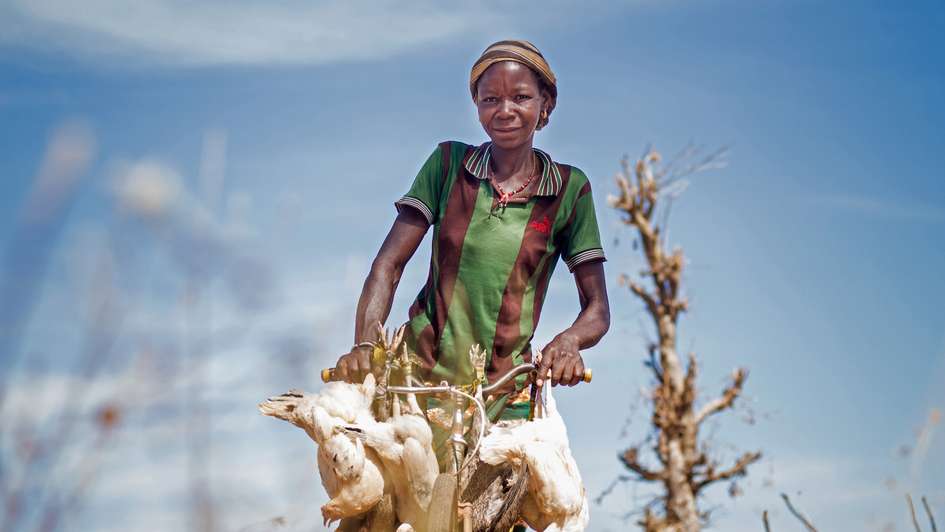
In the 31st edition of "Kompass"[i], the civil society shadow report on German development policy by Welthungerhilfe and terre des hommes, the focus of analysis is on German spending on development cooperation and humanitarian aid. Against the backdrop of an increasingly multipolar world order, political instability and global crises, which necessitate a revision of the German government's Africa Policy Guidelines, the annual report in 2024 also focuses on the German government's Africa policy and the fragile situation in the Sahel region.
ODA is not keeping pace with multiple crises
Contrary to the marginally positive international trend, which saw spending on Official Development Aid (ODA) by OECD countries increase by 1.8 percent compared to 2022, German spending on ODA fell significantly in 2023. For the first time since 2019, the German government's ODA expenditure as a percentage of gross national income (GNI) fell once again in 2023 – from 0.83% of GNI in 2022 to 0.79% in 2023. Overall, German ODA expenditure amounted to 33.9 billion euros, which represents a real decline (adjusted for inflation) of 5.8 percent compared to the previous year.
This decline comes at a critical time as the world faces a multipolar mix of complex crises such as climate change, political instability, the ongoing challenges of the Covid-19 pandemic and growing fragility. How these crises reinforce each other is particularly evident in the central Sahel region: Long periods of drought affect agricultural productivity and contribute to exacerbating food insecurity. At the same time, competition for land as an increasingly scarce resource is increasing between farming communities and nomadic pastoralists, while violence by armed groups is forcing thousands of people to flee, which in turn further increases poverty and hunger.
Lack of political will for food security
Over 733 million people worldwide still suffer from hunger. This is particularly true for the rural and peri-urban population.[ii] The development of agriculture and of rural areas is therefore a decisive lever not only for effectively and sustainably reducing poverty and hunger, but also for increasing people's resilience and thus reducing the risk of igniting new conflicts. This makes it all the more worrying that the funds provided by the Federal Ministry for Economic Cooperation and Development (BMZ) for food security and rural development have been drastically cut: As Kompass 2024 shows, they are falling for the first time since 2018 – by as much as 32 percent compared to the previous year.
Kompass also shows that German ODA to the so-called least developed countries (LDCs) was lower in 2022 than in 2018. Support for this group of countries is also falling as a proportion of total German ODA. In addition, the LDCs receive a large proportion of support in the form of humanitarian aid and food aid, which alleviates immediate crises but contributes little to the development of long-term food security. This despite the fact that in these countries in particular, ODA funds are crucial for investments in agriculture and rural areas.
Recent modelling[iii] shows that a marked political reluctance to promote the human Right to Food in recent years has massively increased the cost of remedial action: The additional cost of achieving the Sustainable Development Goal "Zero Hunger" (SDG 2) by 2030 now amounts to 93 billion dollars per year. In 2020, the cost was calculated at 30 billion dollars per year.
2025 Budget: ODA downward trend continues
The ruling by the Federal Constitutional Court in November 2023, which declared the reallocation of 60 billion euros from the 2021 supplementary budget invalid, has further increased pressure to make cuts in the 2024 federal budget and subsequent budgets. The parties of the ruling so-called Traffic Light Coalition (Social Democrats – red, Free Democrats – yellow, Green Party – green) also fought bitterly over the draft budget for 2025. A cabinet decision expected for July 3 was delayed until July 17 due to disagreements between the coalition parties. During the summer break, additional expert opinions were released which suggested that the budget could still be short of 5 billion euros, which would necessitate further negotiations. It is clear, however, that a continued downward trend in German ODA is imminent. Further significant cuts are planned for development cooperation and humanitarian aid for the 2025 financial year and subsequent years.
Funds for development cooperation are to be reduced by a further eight percent to 10.28 billion euros. Within the BMZ budget, a significant reduction is planned for the special initiative "Transformation of Agricultural and Food Systems" (SI AGER). It is to be cut from EUR 420 million to EUR 345 million, which corresponds to a reduction of 17.9 percent. These cuts will be at the direct expense of long-term investment in food security and rural development.
The cabinet decision also provides for drastic cuts in funding for "crisis prevention, reconstruction and infrastructure", also known as "transitional aid". The funds are to be reduced from 1.04 billion euros in 2024 to 645 million euros, a reduction 395 million euros or 38 percent. This budget position is used to fund projects in fragile and crisis-affected contexts in particular, where emergency aid situations and options for longer-term structural development repeatedly overlap. As it allows instruments with both short-term and long-term effects to be used in parallel and flexibly, this position is particularly important against the backdrop of increasing and ever longer-lasting crises and conflicts. These cuts could also come at the direct expense of Germany's commitment to achieving SDG 2 "Zero Hunger", as this part of the budget has in the past accounted for around 20 percent of the BMZ's expenditure on food security and rural development (see Figure 1)
Cutting the budget of the Federal Foreign Office
The cabinet decision for 2025 cuts the budget of the Federal Foreign Office (AA) to 5.87 billion euros, which corresponds to a reduction of 836 million euros (-12 percent) compared to the 2024 budget. The AA budget was already cut by 18 percent in 2024. The cuts mainly affect funds for humanitarian aid. They are to fall by a full 53 percent from 2.23 billion euros in 2024 to 1.04 billion euros in 2025. The German government thus risks significantly weakening its ability to respond to extreme weather events and an increasing number of conflicts. The impact of violent conflicts on populations is already devastating, as the current situation in numerous countries and regions – including Ukraine, Yemen, Gaza, Sudan and the Sahel – makes clear.
With these cuts, it will hardly be possible to achieve the internationally agreed ODA quota of 0.7% of GNI. This trend could have an impact on other donor countries: If a leading economy like Germany withdraws from internationally agreed targets, it is to be feared that less committed donor countries will be all the more reticent.
The German government's Africa policy needs coherent answers
Africa has long been regarded as an attractive partner for key issues such as the shortage of skilled workers, the energy transition and climate protection. Its geopolitical importance is increasing. Of the 20 countries with the fastest growing economies, 11 are on the African continent and, according to the African Union, Africa has the youngest population in the world with an average age of 19.[iv] Even though there has not yet been sufficient success in ensuring that particularly vulnerable groups also benefit from this growth, the outdated narrative of "Africa as a continent in crisis" must be overcome and Africa's role as a sought-after partner must be recognized.
At the same time, the growing number of democratically illegitimate governments in the Sahel region on the one hand and the increasing influence of Islamist militias and other terrorist organizations on the other are raising concerns about the continued existence of stable states. Reliable partnerships in the region are at stake, as is geopolitical stability. The Sahel region alone has experienced five coups d'état in the past four years – two in Mali (2020 and 2021), two in Burkina Faso (2022) and one in Niger (2023). 33 of the 45 countries that need food aid worldwide are in Africa[iv], and ten of the 15 countries that the OECD classifies as extremely fragile are also on the African continent.[v]
Against this backdrop, it is only logical that the German government is revising the Africa Policy Guidelines (APL) under the leadership of the Federal Foreign Office and intends to publish them this year. Kompass 2024 sets out important requirements for the German government:
Creating genuinely eye-level and cross-departmental policy responses:
For a partnership truly at eye level, the revision of the APL requires close coordination with existing African strategies and concepts (e.g. Agenda 2063, Post-Malabo). Existing committees and exchange formats should be used more intensively to deepen dialog. This is the only way to create greater coherence between German interests, the APL and African strategies and concepts and to make an effective joint contribution to implementing the 2030 Agenda.
The Kompass shows that it is particularly important to adapt the numerous existing guidelines and strategies of the ministries to the revised APL in a coherent manner. The relevant ministries should develop specific country strategies with clear objectives in close coordination with African partners in order to improve interministerial cooperation.[vii] In the context of upheavals and possibly differing values of the negotiating partners, realistic objectives that are communicated transparently to the other party can provide the continuity and support that the population in the countries concerned needs.
Promote a strong civil society:
Particularly in fragile contexts such as the Sahel and where intervention independent of state structures is necessary, non-governmental organizations (NGOs) and local civil society initiatives play a central role in sustainable development projects. NGOs are able to provide support even in acute crises and have developed strategies to deal with fragile situations and recurring hotspots. Through relationships based on trust with local communities and cooperation with partner organizations, working with communities remains possible even in fragile contexts, and longer-term cooperation can continue even if bilateral cooperation at government level has to be temporarily suspended. This applies in particular to humanitarian aid organizations and organizations with a dual mandate, which due to their principles of neutrality and impartiality can negotiate access to people in need of help even in complex conflict situations.
Focus on the human Right to Food and rural development:
The human Right to Food remains unfulfilled for large parts of the population in the Sahel. Women, young people and other vulnerable groups are particularly affected. In Burkina Faso, Mali, Niger, Mauritania and Chad alone, 10.8 million people are currently affected by acute food insecurity.[viii] Observers estimate that 204 million people in African countries alone will be dependent on food aid in October of this year.[ix]
The targeted strengthening of agricultural production in many regions of Africa, including the Sahel region, can make an important contribution to the sustainable eradication of hunger and malnutrition and thus help to reduce the need for food aid. Despite this potential, however, only a small proportion of German ODA for agriculture and rural development goes to the Sahel countries of Burkina Faso, Chad, Mali, Mauritania and Niger, as Kompass 2024 shows.
In cooperation with the Sahel region, the German government should therefore provide greater support for the agricultural and food sector. In particular, priority should be given to transforming impoverished smallholder households into socially, ecologically and economically sustainable (family) enterprises and the creation of income opportunities in rural areas. Examples of necessary measures are:
- Promoting the further processing of agricultural (raw) products.
- Investment in modern production techniques and in the processing, storage, cooling, transportation and marketing of products.
- Measures to adapt to climate change and strengthen climate resilience.
- Promotion of training initiatives to create long-term prospects.
This would be welcome not only from a humanitarian but also from an economic perspective and should be reflected accordingly in the Africa Policy Guidelines.

[i] Editorial Team: Silvia Richter, Frauke Bohner, Dr. Rafaël Schneider, Asja Hanano, Wolf-Christian Ramm, Jonas Schubert, Katharina Debring; Authors: Bettina Ide, Justyna Szambelan, Frauke Seidensticker, Jonas Schubert, Christian Roßbach
[ii] von Braun, Joachim et al. (2024): Cost of Ending Hunger – Consequences of Complacency and Financial Needs for SDG2 Achievement. ZEF Discussion Papers on Development Policy No. 347, Center for Development Research, University of Bonn
[iii] von Braun, Joachim et al. (2024): Cost of Ending Hunger – Consequences of Complacency and Financial Needs for SDG2 Achievement. ZEF Discussion Papers on Development Policy No. 347, Center for Development Research, University of Bonn.
[iv] African Development Bank Group (2024): Africa’s Macroeconomic Performance and Outlook. Available at: www.afdb. org/en/documents/africas-macroeconomicperformance-and-outlook-january-2024 (accessed: 31.05.2024)
[v] FAO (2024): Crop Prospects and Food Situation. Triannual Global Report. Available at: openknowledge.fao. org/server/api/core/bitstreams/8ce51384- f3d4-4598-8c57-bb38cfd5b06e/content (accessed: 31.05.2024).
[vi] 24 OECD (2022): States of fragility report. Available at: www.oecd.org/dac/states-offragility-fa5a6770-en.htm.
[vii] Advisory Board to the Federal Governmentfor Civilian Crisis Prevention and Peacebuilding; https://beirat-zivile-krisenpraevention.org
[viii] FSIN and Global Network Against Food Crises (2024): GRFC 2024. Available at: www.fsinplatform.org report/global-report-food-crises-2024 (accessed: 31.05.2024).
[ix] Famine Early Warning Systems Network (2024): Food Assistance Outlook Brief April 2024. Available at: fews.net/sites/ default/files/2024-04/FAOB-April%202024.pdf

